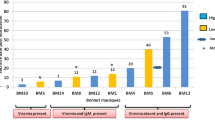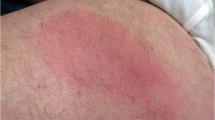Abstract
TSETSE-TRANSMITTED African pathogenic trypanosomes are thought to be divisible into two groups because of their distribution in the mammalian host and the characteristic lesions they produce during infection1. Trypanosoma brucei brucei and related subspecies have a wide distribution in the body, parasitising the intercellular fluids, connective tissue and parenchymatous tissues, and the fluids of body cavities2–4, whereas T. vivax and T. congolense are considered to be strictly plasma parasites, confined to the circulatory system5,6. It has been shown, however, that local skin reactions develop at the sites of bites of tsetse flies infected with T. congolense, and fluid expressed from reaction sites contains trypanosomes several days before they can be detected in the peripheral blood7–9. We have recently examined the development of T. congolense in local reactions and give evidence here from light and electron microscopy that the trypanosomes develop in connective tissue. The multiplication and persistence of trypanosomes at the site of infection have important implications in relation to immunogenesis and might also play a part in the pathogenesis of the ensuing disease and the efficiency of chemotherapy.
This is a preview of subscription content, access via your institution
Access options
Subscribe to this journal
Receive 51 print issues and online access
$199.00 per year
only $3.90 per issue
Buy this article
- Purchase on Springer Link
- Instant access to full article PDF
Prices may be subject to local taxes which are calculated during checkout
Similar content being viewed by others
References
Losos, G. J. & Ikede, B. O. Vet. Path. 9 (Suppl.). 1–71 (1972).
Goodwin, L. G. Trans R. Soc. trop. Med. Hyg. 65, 82–88 (1971).
Ikede, B. O. & Losos, G. J. Vet. Path. 9, 272–277 (1972).
Ormerod, W. E. in The African Trypanosomiases (eds Mulligan, H. W. & Potts, W. H.) 587–601 (George, Allen & Unwin, London, 1970).
van den Ingh, T. S. G. A. M., Zwart, D., Schotman, A. J. H., van Miert, A. S. J. P. A. M. & Veenendaal, G. H. Res. vet. Sci. 21, 264–270 (1976).
Losos, G. J., Paris, J., Wilson, A. J. & Dar, F. K. Bull. epizoot. Dis. Afr. 21, 239–248 (1973).
Bolton, M. A. Food and Agricultural Organization of the United Nations, Rep. to Govt UK, No. TA 2895 (Rome, 1970).
Roberts, C. J., Gray, M. A. & Gray, A. R. Trans R. Soc. trop. Med. Hyg. 63, 620–624 (1969).
Uilenberg, G., Maillot, L. & Giret, M. Revue Elev. Med. vet. Pays trop. 26, 27–35 (1973).
Fiennes, R. N. T. W. Ann. trop. Med. Parasit. 44, 222–237 (1950).
Fiennes, R. N. T. W. Br. vet. J. 108, 298–306 (1952).
Tizard, I. R. & Holmes, W. L. Experientia 32, 1533–1534 (1976).
Tizard, I. R., Nielsen, K., Mellors, A. & Assoku, R. K. Lancet i, 750–751 (1977).
Wolbach, S. B. & Binger, C. A. L. J. med. Res. 27, 83–107 (1912).
Hirumi, H., Doyle, J. J. & Hirumi, K. Science 196, 992–994 (1977).
Author information
Authors and Affiliations
Rights and permissions
About this article
Cite this article
LUCKINS, A., GRAY, A. An extravascular site of development of Trypanosoma congolense. Nature 272, 613–614 (1978). https://doi.org/10.1038/272613a0
Received:
Accepted:
Issue Date:
DOI: https://doi.org/10.1038/272613a0
This article is cited by
-
Proteome remodelling during development from blood to insect-form Trypanosoma brucei quantified by SILAC and mass spectrometry
BMC Genomics (2012)
-
Trypanosomosis research at the centre for tropical veterinary medicine (CTVM) 1970 to 1995
Tropical Animal Health and Production (1996)
Comments
By submitting a comment you agree to abide by our Terms and Community Guidelines. If you find something abusive or that does not comply with our terms or guidelines please flag it as inappropriate.



